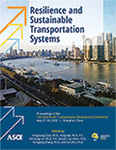13th Asia Pacific Transportation Development Conference
Analyzing and Modeling Post-Earthquake Emergency Traffic Demand
Publication: Resilience and Sustainable Transportation Systems
ABSTRACT
The earthquake emergency channel is an important disaster prevention and shock absorption infrastructure for the city and plays an important and fundamental role in the post-earthquake rescue work. Based on the urban actual seismic hazard, an improved four-step method and scenario construction method are used to establish a multi-scenario urban earthquake emergency access system. First, researchers conducted post-earthquake demand node analysis from emergency rescue, medical rescue, and material rescue. Then, based on the post-earthquake activity, the Dijstra shortest path algorithm and the original unit method are used to predict the traffic demand. Finally, based on the principle of near distribution and the principle of balanced distribution, four scenarios are constructed, which consider time, traffic demand, and bridge condition factors. The four scenarios are the shortest path model with intact bridge, the shortest path model with damaged bridge, the balanced distribution model of bridge, and the balanced distribution model of bridge damage. In order to verify the validity of the model, Beijing was selected as the research area, and the traffic demand allocation and result solving were carried out by means of the Beijing road network VISUM model. The road network results of the post-earthquake emergency channel under four scenarios were obtained. At the same time, combined with scenarios 1 and 3, the researchers recommended a comprehensive post-earthquake emergency access road network. The method proposed by the researcher is very operational, and the result can provide decision-making basis for the post-earthquake contingency planning of the urban transportation system. At the same time, the proposed method can provide theoretical reference for post-earthquake emergency channel planning in other cities.
Get full access to this article
View all available purchase options and get full access to this chapter.
ACKNOWLEDGMENTS
This research was supported by the Fundamental Research Funds for the Central Universities of Ministry of Education of China (2019YJS107), National Natural Science Foundation of China (71501011), and Beijing Road Network VISUM Model from Beijing Transport Institute
REFERENCES
Chen, Y., and Eguchi, R. T. (2003). “Post-earthquake road unblocked reliability estimation based on an analysis of randomicity of traffic demands and road capacities.” US Conference & Workshop on Lifeline Earthquake Engineering, 916-925.
Dijkstra, E. W. (1959). “A note on two problems in connection with graphs.” Numerische Mathematik, 1(1), 269-271.
Gao, W., Lan, H., Tang, G. (2013). “Comparative Study on Seismic Design of Bridges ‘08 Detailed Rules’ and ‘89 Specification’ in Seismic Design of Some Simply Supported Beam Bridge.” Technology of Highway and Transport, 3, 33-36.
Guo, A., Liu, Z., Li, S., and Li, H. (2017). “Seismic performance assessment of highway bridge networks considering post-disaster traffic demand of a transportation system in emergency conditions.” Structure and Infrastructure Engineering, 13(12), 1523-1537.
Guo, D., Wang, J., Zhao, J. B., Sun, F., et al. (2019). “A vehicle path planning method based on a dynamic traffic network that considers fuel consumption and emissions.” Science of the Total Environment, 663, 935-943.
Han, R., and Zhang, C. (2019). “Big Data Analysis on Economical Urban Traffic in Beijing Organize overlapping transportation though the underground diameter line of Beijing railway hub.” 4th IEEE International Conference on Cloud Computing and Big Data Analysis, 269-273.
Kim, K., Pant, P., and Yamashita, E. (2017). “Integrating travel demand modeling and flood hazard risk analysis for evacuation and sheltering.” International Journal of Disaster Risk Reduction, 31, 1177-1186.
Lin, H. Z., and Wei, J. (2019). “Optimal transport network design for both traffic safety and risk equity considerations.” Journal of Cleaner Production, 218, 738-745.
Ma, Y., Xu, W., and Zhao, X. (2014). “Assessment of allocation of residents to emergency shelters under different earthquake damage scenarios - case study on central area of Beijing”. China Safety Science Journal, 24(12), 138-143.
Suda, T., Murakami, A., Nakamura, Y., Sasaki, H., et al. (2019). “Medical needs in Minamisanriku Town after the Great East Japan Earthquake.” Tohoku Journal of Experimental Medicine, 248(2), 73-86.
Vahdani, B., Veysmoradi, D., Shekari, N., and Mousavi, S. M. (2018). “Multi-objective, multi-period location-routing model to distribute relief after earthquake by considering emergency roadway repair.” Neural Computing & Applications, 30(3), 835-854.
Wang, F., Ye, C., Wang, T., and Zhao, J. (2018). “Research on two stage planning model and algorithm of wounded rescue vehicle after earthquake.” Journal of management sciences in China, 21(2), 69-79.
Yuan, Y. F. (2008) “Impact of intensity and loss assessment following the great Wenchuan Earthquake.” Earthquake Engineering and Engineering Vibration, 7, 247-254.
Yang, E., Li, J., Yan, Y., and Huang, W. (2016). “Location routing model for post-earthquake multi-stage distribution with multi-type emergency supplies.” Journal of Catastrophology, 31(2), 200-205.
Zhang, T., Cao, Z., Wu, K., et al. (2018). “Hybrid genetic algorithm for earthquake relief path optimization problem.” Science Technology and Engineering, 18(1), 266-272.
Zhang, X., Zhao, H., Wang, F., et al. (2018). “Rapid assessment of seismic fatality based on scenario analysis.” Journal of Catastrophology, 33(4), 197-203.
Zhu, J., Liu, S., and Ghosh, S. (2019). “Model and algorithm of routes planning for emergency relief distribution in disaster management with disaster information update.” Journal of Combinatorial Optimization, 38(1), 208-223.
Information & Authors
Information
Published In
Resilience and Sustainable Transportation Systems
Pages: 166 - 175
Editors: Fengxiang Qiao, Ph.D., Texas Southern University, Yong Bai, Ph.D., Marquette University, Pei-Sung Lin, Ph.D., University of South Florida, Steven I Jy Chien, Ph.D., New Jersey Institute of Technology, Yongping Zhang, Ph.D., California State Polytechnic University, and Lin Zhu, Ph.D., Shanghai University of Engineering Science
ISBN (Online): 978-0-7844-8290-2
Copyright
© 2020 American Society of Civil Engineers.
History
Published online: Jun 29, 2020
Published in print: Jun 29, 2020
Authors
Metrics & Citations
Metrics
Citations
Download citation
If you have the appropriate software installed, you can download article citation data to the citation manager of your choice. Simply select your manager software from the list below and click Download.
